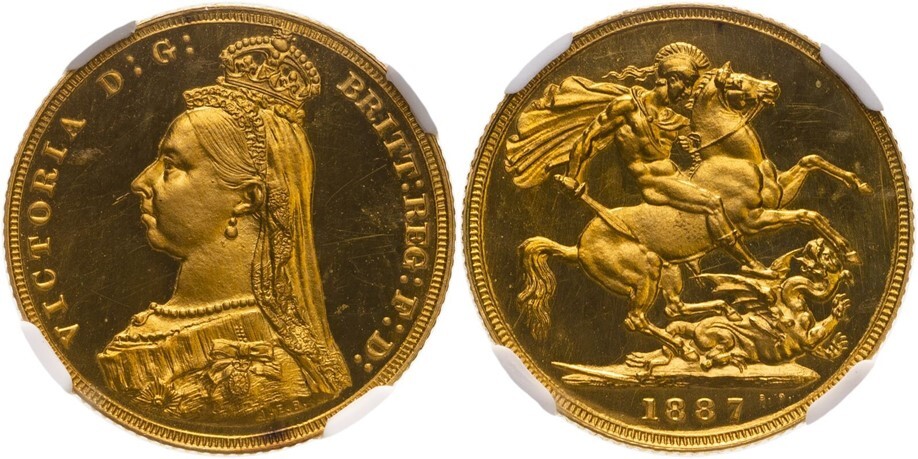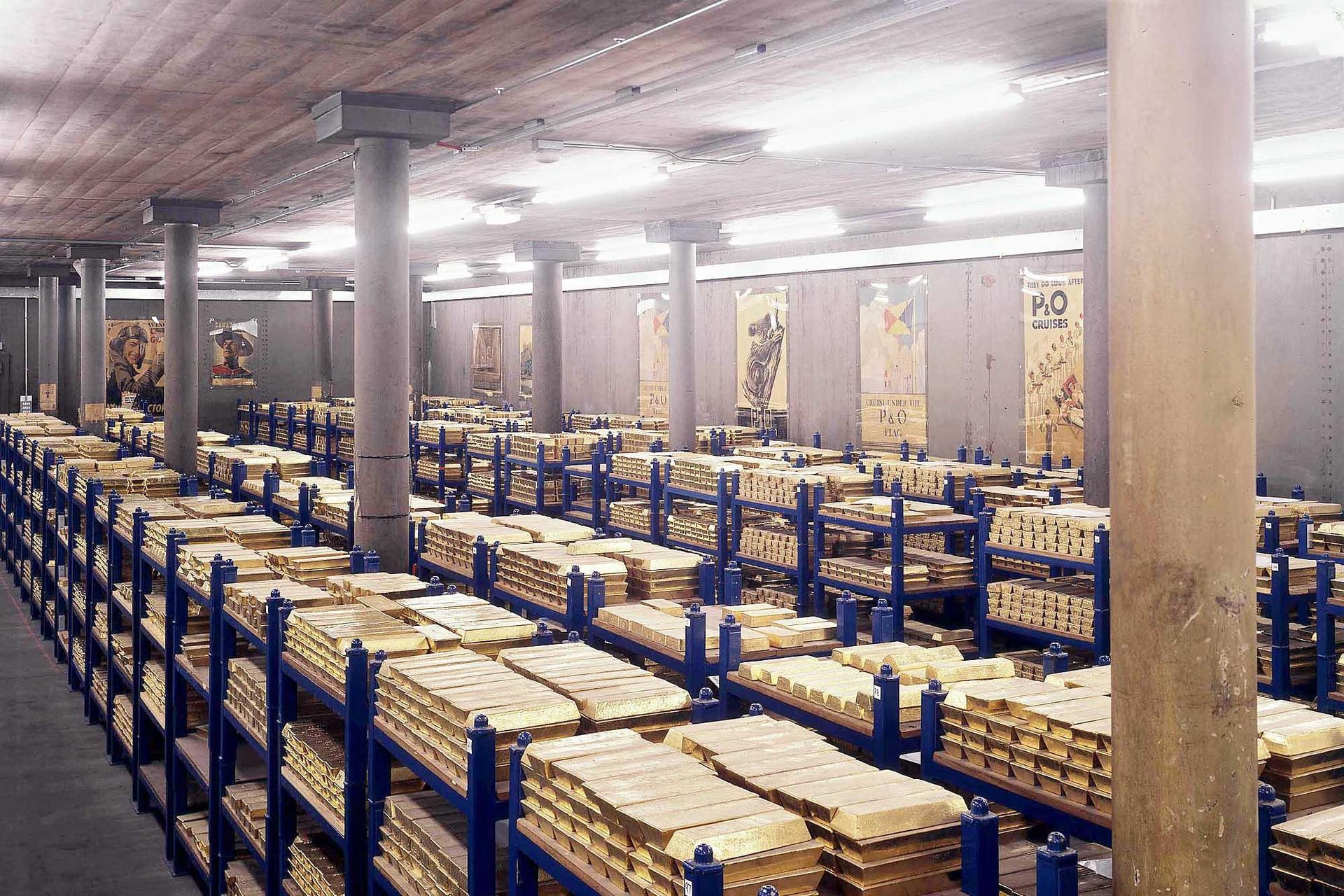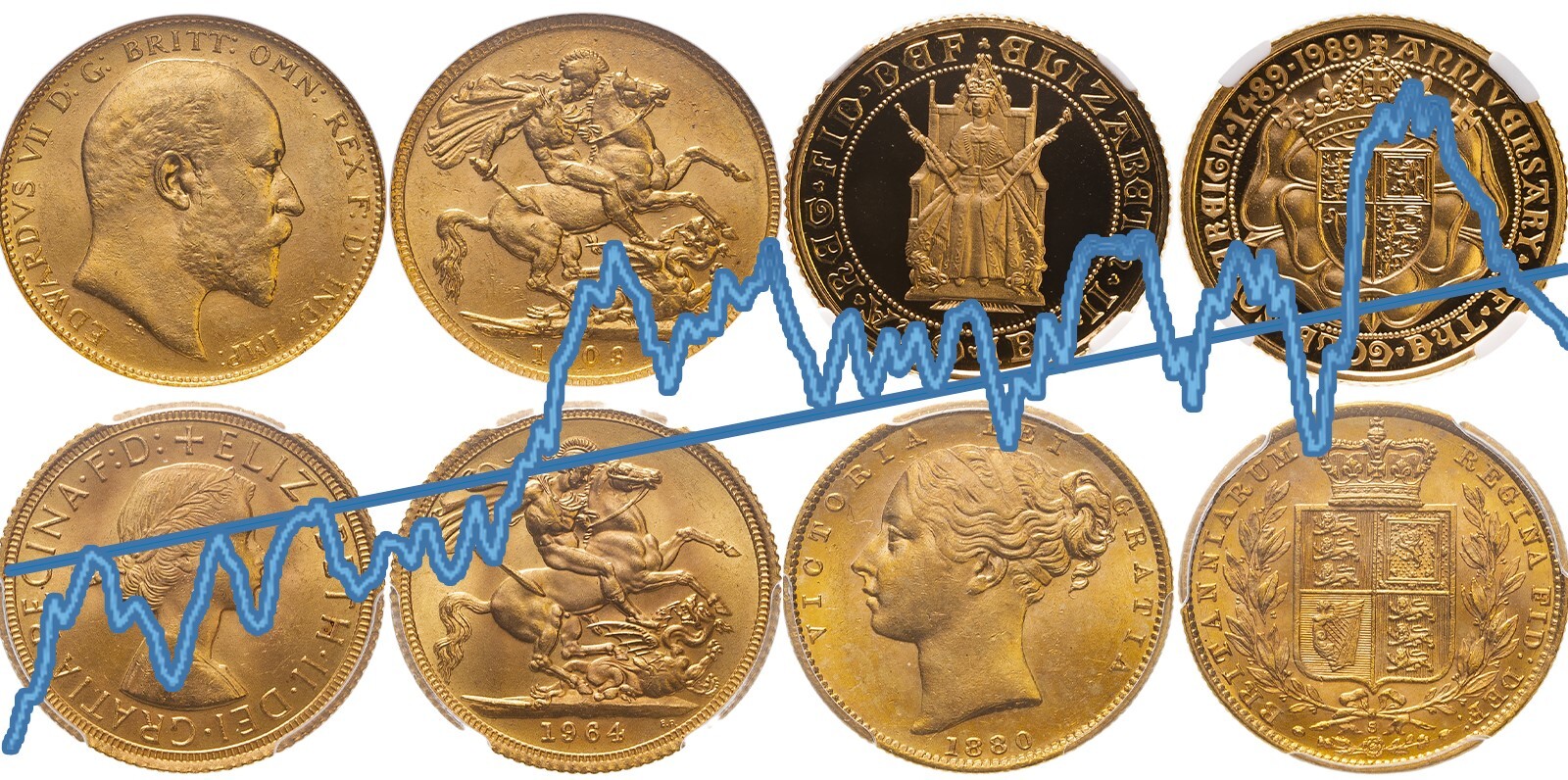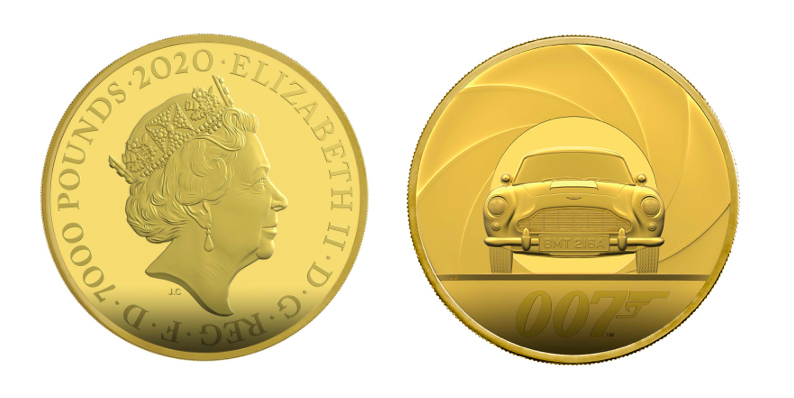Coming up in auction #100 on 29 December 2023
Obv: Crowned and veiled Jubilee bust facing left, JEB with angled J on truncation; first legend (D:G closer to crown), legend reads VICTORIA D:G: BRITT: REG: F: D:.
Rev: St George on horseback slaying the dragon; date and B.P. in exergue.
General references: Unlisted, previously unknown to exist. Will be published in next print version of Wilson & Rasmussen.
Collection references: -
Certification number 6671222-001.
This seemingly unique pattern proof was struck using the same dies that was used for the First Head circulation coins. The First Head circulation coins were rushed into production to be used for the Queen's Golden Jubilee in June 1887. This production had major issues because of the low relief and placement of design elements. A large proportion of coins had to be melted and restruck. Silver was used for the alloy instead of copper to harden the metal and improve metal flow, giving 1887 London mint Jubilee head sovereigns their distinct lighter yellow colour. All regular proofs were struck after the Jubilee in June 1887 and were struck using the reworked Second Head. A First Head Proof is a complete anomaly which was presumed not to exist until this coin surfaced. It is quite possible to have been presented to Queen Victoria for approval of the final design.
Price comparables (R7 rarity Jubilee head sovereigns)
1891 Proof Sovereign PR65+ Deep Cameo PCGS
Heritage Auctions #3088, lot 33193, 5 November 2020, $72,000 (c. £55,200) inc. BP.
Same ex: Bentley Collection, Baldwin's Auction 73, May 2012, Lot 330, £13,200 inc. BP.
This coin had a 20% CAGR during these 8 years.
KM767 (unlisted in Proof), S-3866C, W&R-337 (R7; this coin). Reeded edge. Long tail variety. By Joachim E. Boehm. While the 1891 saw a standard mintage of well over 5 million more pieces struck than the famed 1887 that inaugurated the series, the Proof from this date represents a significant rarity that is not even touched upon by its predecessor--whereas we know that 797 Proofs were produced in 1887 (for Victoria's Diamond Jubilee Proof Set), Wilson and Rasmussen's R7 rating suggests only 1-2 known for 1891, with the other specimen likely stemming from the Douglas-Morris collection (struck from the same dies). Altogether missing from Montagu, Murdoch, and Nobleman, this is the first time an example has become available in over 8 years. Effortlessly gem and profusely die polished, it is eye candy at its finest.
Ex. Bentley Collection (Baldwin's Auction 73, May 2012, Lot 330),
Purchased from Randy Weir (December 1995)
Extract from Bentley Collection description (above, same 1891 proof sovereign)
THE BENTLEY COLLECTION OF BRITISH MILLED GOLD SOVEREIGNS. Victoria, Proof Sovereign, 1891, engraved after Joseph Edgar Boehm, Jubilee tall veiled bust left, with small Imperial crown, top cross on field within the border, wearing 13 pearl necklace, brooch at front with relief jewel, half a garter star at base of bust under sash, decorated border to dress bust, J.E.B. on edge of truncation into field with stops, angled J, repositioned second legend closer to crown, two pearl drop ear ring, VICTORIA D:G: BRITT: REG: F: D:, finely toothed border within twin linear concentric circles and raised rim both sides, outer rim blends with teeth, rev struck en médaille, engraved after Benedetto Pistrucci, St George slaying dragon with sword, different helmet streamer, one long incomplete strand, cloak complete, one strand of mane hair over rein hand, horse with long tail, three strand end to tail, two spurs of extra hair on curve of tail, dragon with four claws to left and three to right foreleg, one claw detached, broken lance on ground-line to left, WWP in relief under lance, date in exergue, wide spread full B.P. to upper right, edge milled, 7.97g, 22mm (WR 337 R7, this coin illustrated; DM 220). Brilliant, just a few hairlines, otherwise mint state and extremely rare
ex Randy Weir Numismatics, Unionville, Ontario, Canada, purchased December 1995, NYINC, Sheraton Hotel, New York.
This coin is the one used for illustration in the publication, English Pattern Trial and Proof Coins in Gold by Wilson and Rasmussen.
This coin is the initial issue of the new long tail reverse design for the Jubilee issue, perhaps it was commissioned in light of the demise of J E Boehm who was close to the Royal Family, having been with Princess Louise, Duchess of Argyll when he died.
The Jubilee Style Bust Coinage For the Golden Jubilee of Queen Victoria
Much like today with our current Queen's Diamond Jubilee in 2012, preparations for Queen Victoria's Golden Jubilee of 1887 were underway years in advance. The Queen herself had first signified that she was willing for a change in portrait on the coinage as she had been most impressed by a portrait medal of her effigy by Mr Joseph Edgar Boehm RA (6 July 1834 - 12 December 1890) modelled from life. A large plaster model was prepared by Boehm in his studio, and from this metal copies were taken and then reduced for coinage. The first proposed coinage patterns appear from 1880 in base metals and silver, the Queen having sat for her portrait with Boehm in February of that year. The resulting currency coinage produced for 1887 included a commemorative gold Five Pound and Two Pound coin issued together for the first time since 1826. There were sets available in various guises officially for sale as proof or currency quality, with cases costing extra. The Jubilee coinage also marks for the first time in the British currency coinage the die axis being upright (en médaille). All die axes previously on coinage were of the inverted orientation and upright axis was reserved for medals or patterns. The obverse legend appears slightly more abbreviated than the last young head issue too. Apart from this, and the obvious bust change, the coinage is very similar to the previous young head St George type with a milled edge.
The story of the gestation of the coinage was revealed in a series of Royal Mint correspondence, the elements of which have been published in the British Numismatic Journal by G P Dyer and Mark Stocker in 1984. What can be seen is that the resulting currency coins were received with mixed reaction from the public, much to the consternation of C W Fremantle, the Deputy Master of the Mint who had fully supported the design. The populous accepted the change in celebration of the Jubilee, but more seriously criticism of the design was given by critics at the Royal Academy for the way the crown appeared upon the Queen's head, and the coinage was much discussed in Parliament. Comments ranged from such as "this toy crown" and "too small to be realistic," as had the Queen turned or moved the crown would have tumbled from her head.
More seriously, the Sixpence and Half-Sovereign coins being of similar dimensions and unfortunately of similar design, meant the Sixpences were quickly gilt by the unscrupulous and passed as gold coins. The Numismatic Society again were vocal about this, saying that the Mint had a precedent in 1821 when the Half Sovereign design had to be changed after one year as it was too similar to the sixpence. In 1887 the Sixpence became the withdrawn coin and the reverse design regressed to what it was before. The Numismatic Society and its President Sir John Evans, amongst others, continued to criticise the designs and the Jubilee portrait only lasted on British coins from 1887-1892 inclusive. Even the Queen herself had remarked on her displeasure of this coinage during 1888. In Melbourne and Sydney, Australia, the portrait continued briefly into 1893 on the gold coins. Boehm having died in 1890 was no longer around to see the change so soon after the Jubilee, and the criticism received may well have contributed to his demise, though he was kept very busy with his sculpture work.
For further reading see British Numismatic Journal 1984, p.274-288 "Edgar Boehm and the Jubilee Coinage" by G P Dyer and Mark Stocker.
1888 M Proof Sovereign 2nd Head FDC, as struck
Bentley Collection, Baldwin's Auction 73, Sep 2012, Lot 796, £34,800 inc. BP.
Using the same CAGR calculation (20% CAGR) of the 1891 Proof sovereign above, this indicates a value of £146,000 in 2020.
THE BENTLEY COLLECTION OF MILLED GOLD SOVEREIGNS.
PART TWO. Colonial Gold Issues. SOUTH AUSTRALIA. The Sydney Branch Mint. The Extremely Rare 1888 Melbourne Proof Sovereign with second legend. Victoria, Sovereign, 1888 M, Jubilee style bust left, J.E.B. on edge of truncation with an angled J, the letters intrude the field, second type legend with G: closer to crown, the top cross clear of the border circle, rev St George slaying dragon with sword, complete hem to cape, horse with short tail, two small spurs of extra hair at upper curve, dragon with all claws attached, three to upper arm, four to lower arm, M mint mark at centre of ground, date in exergue, B.P. complete to upper right, 7.98g (cf McD.177b; QM -; Marsh -; KM 10; Fr 20; cf S 3867B). Toned as struck FDC and of the highest rarity, a beautiful coin.
ex Paul Davies Ltd, purchased before 2005
For another example of one of these rare proofs of this second legend type see KJC Inaugural Monetary Auction, 10 June 2005, lot 809. These were struck in reaction to a request from the new Deputy Master, George Anderson, who wanted to mount a display of coins at the 1888 International Exhibition in Melbourne, following in the tradition of a display at the 1880 Exhibition by his predecessor. He made a request to the Royal Mint London to supply these proofs which was at first refused because C W Fremantle in London envisaged the request as a restrike of what had already been struck in 1880. However, Anderson reassured the mint he merely wanted examples of what may already be available in stock from 1880, rather than fresh strikes and other current productions as and when the mint could strike for them. Fremantle was happier with this second request and supplied Melbourne with specimen proof strikings from this date forward as long as they paid the face value for them. This started with the Colonial coins of 1888, including examples like this 1888 Proof Sovereign. For further reading on the subject of special strikings made by the mint for exhibition in Australia see the Journal of the Numismatic Association of Australia, volume 2, article by John Sharples "The Numismatic Collection of the Museum of Victoria" available online at the Association website.
The McDonald publication for 2012 only lists the 1888M with the first type legend, probably a misprint as this proof of the second legend was listed as McD177a. Nevertheless the 1888M Proof is a major rarity and the variety listed by McDonald has a valuation in Proof quality of AU$180,000 (or .£121,000).
Unique (R7) silver striking of 1887 M Sovereign. Proof, toned
Bentley Collection, Baldwin's Auction 76, Sep 2012, Lot 787, £15,600 inc. BP.
A 20% CAGR for a silver coin seems too high. A 15% CAGR gives a value of over £50,000 today.
THE BENTLEY COLLECTION OF MILLED GOLD SOVEREIGNS.
PART TWO. Colonial Gold Issues. SOUTH AUSTRALIA. The Sydney Branch Mint. Unique Silver Striking of an 1887 Melbourne Mint Sovereign. Victoria (1837-1901), Pattern Sovereign,1887 M, struck in silver, engraved by Joseph Edgar Boehm, Jubilee tall veiled bust left with older features, veil with two rows of crenellations, with small Imperial crown, large fleurs inside, top cross of crown touches linear circle, wearing 14 pearl necklace, brooch at front with relief jewel, almost full garter star at base of bust under sash, decorated border to dress bust, prominent and robust J.E.B. fully on truncation, hooked J doubled, repositioned second legend closer to crown, two pearl drop ear ring, VICTORIA D:G: BRITT: REG: F: D:, finely toothed border within twin linear concentric circles and raised prominent rim both sides, rev struck en médaille, after Benedetto Pistrucci, St George slaying dragon with sword, no streamer to helmet as young head reverses, extra mane hair above hand holding rein, horse with short tail, three strand end to tail, no extra hair on curve of tail, dragon with three claws to upper and four to lower arm, shorter fourth claw, all attached, broken lance on ground-line to left, WWP in relief under lance, M mint mark at centre of ground, date in exergue, 7 of date with upper right serif with foot, tiny BP without stops to upper right, edge plain, 4.66g, 21.8mm (McD 175c and note this coin; QM -). Very attractively toned, mint state proof and the only known specimen, unique.
ex A H F Baldwin collection
ex Spink Australia Sale 2, 2 November 1978, lot 613
ex Noble Numismatics Sale 70, 9-11 July 2002, lot 123,2 sold for $26,500
The McDonald catalogue for 2012 rates lists this coin in proof quality at a valuation of AU$190,000 (or .£128,000) the same as many of the gold proof Sovereigns.




